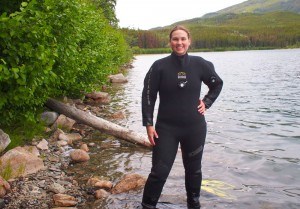Jasper National Park is a place of great heights, but did you know there is also a depth to be explored?

Thirty metres under the water of Patricia lake lies a piece of Canadian history that very few people know about: Project Habbakuk.
The top-secret military project was the vision of England’s wartime Prime Minister Winston Churchill, who wanted to build an unsinkable, undetectable aircraft carrier out of Pykrete, a mixture of ice and sawdust.
The military deemed Patricia Lake a suitable location to build a prototype of the project because of the cold climate and access to a rail line. Although the prototype proved to be a success, the project was eventually scrapped and sunk to the bottom of the lake.
For years the remains of the boat lay mostly forgotten, a small footnote of history, until Nathan D’Heer, owner and instructor of Jasper Dive Adventures, decided to open up a scuba diving company in 2012.
Scuba diving has been a passion of mine since 2010 when I took my first scuba diving course in Barbados. The mystery of the water and the secrets it held fascinated me and before I knew it I was hooked. There’s something to be said about peeking into a world where humans aren’t naturally supposed to be.
Over the years I continued to peruse my passion and eventually became an advanced open water diver. During those years I got used to diving in warm salt water, at sea level, from a boat, so going into this I knew it would be completely different.
In Jasper divers have to deal with cold, fresh water, at altitude and in this case dive from the shore. The conditions couldn’t have been more backwards for me.
D’Heer, whose family has operated Patricia Lake Bungalows for 50 years, started Jasper Dive Adventures after returning from Grand Cayman where he worked as a dive instructor. When he recognized the allure of the Habbakuk wreck, he began offering a guiding service to divers. The company has since evolved into a training facility and an equipment-servicing centre.
Before I was allowed to dive I was required to complete a drysuit training course, a requirement for every Habbakuk tour. A dry suit is typically used when the water temperature is below 15 degrees Celsius, which is necessary in Jasper. It’s a one-piece suit made from either neoprene or foam rubber and sealed at the wrists and neck to prevent any water from entering the suit, thus keeping you dry and warm even when the water is only four degrees Celsius, as is the case in Patricia Lake.
Getting into the water for the first time was a lot more comfortable than I anticipated. Although a dry suit requires more skills and attention, I got the hang of it and spent most of my time focusing on my buoyancy, a crucial skill for any scuba diver.Â
The bottom of Patricia Lake is 90-feet deep and covered in fine glacial silt that can range from one inch to 10-feet deep and the smallest movements and disturbance will create a cloud of silt that greatly reduces your visibility.
After demonstrating some new suit skills to D’Heer, I was given the green light to return the following day to do the dive.
To get to the wreck, we took a short boat ride to the east side of the lake and landed on shore to prepare for the dive. After putting on all of the gear, which weighed more than 30 pounds, we descended down a buoyed line to the Habbakuk.
At 30 feet deep, we crossed our first thermocline to colder water and I could feel the pressure of the water start to squeeze my suit. Since the dry suit is sealed with air, the pressure of the water compresses the suit against your body, much like when you submerge a water bottle and it collapses in on itself.
To alleviate the pressure there is an air hose from the tank attached to the suit which pumps in air reducing the pressure.
This happened two more times as we descended past 60 feet, and finally at 90 feet, where the temperature hovers at a cool four degrees Celsius.
Thankfully, the dry suit did its job and kept me warm, but any part of my skin which was exposed was ice cold and eventually my gloved fingers also started to go numb.
After adapting to the new environment I was able to enjoy the 25-minute dive and explore what remains of the Habbakuk, which includes the wooden planks from the boats walls—one of which is still standing—ductwork, and bitumen. A commemorative plaque was also installed at the bottom of the sloped lake about 30 feet underwater for divers to read as they explore the wreck.
I have to admit that without the intriguing story about the project an uninformed diver may just see a pile of wood at the bottom of a lake. But being able to see first hand a piece of Jasper’s history that’s not located in a museum is what made this tour unique.
So the next time you’re looking to challenge yourself and explore something new, remember, there is a world of underwater possibilities.
Laura Coulson Special to the 51°µÍø
